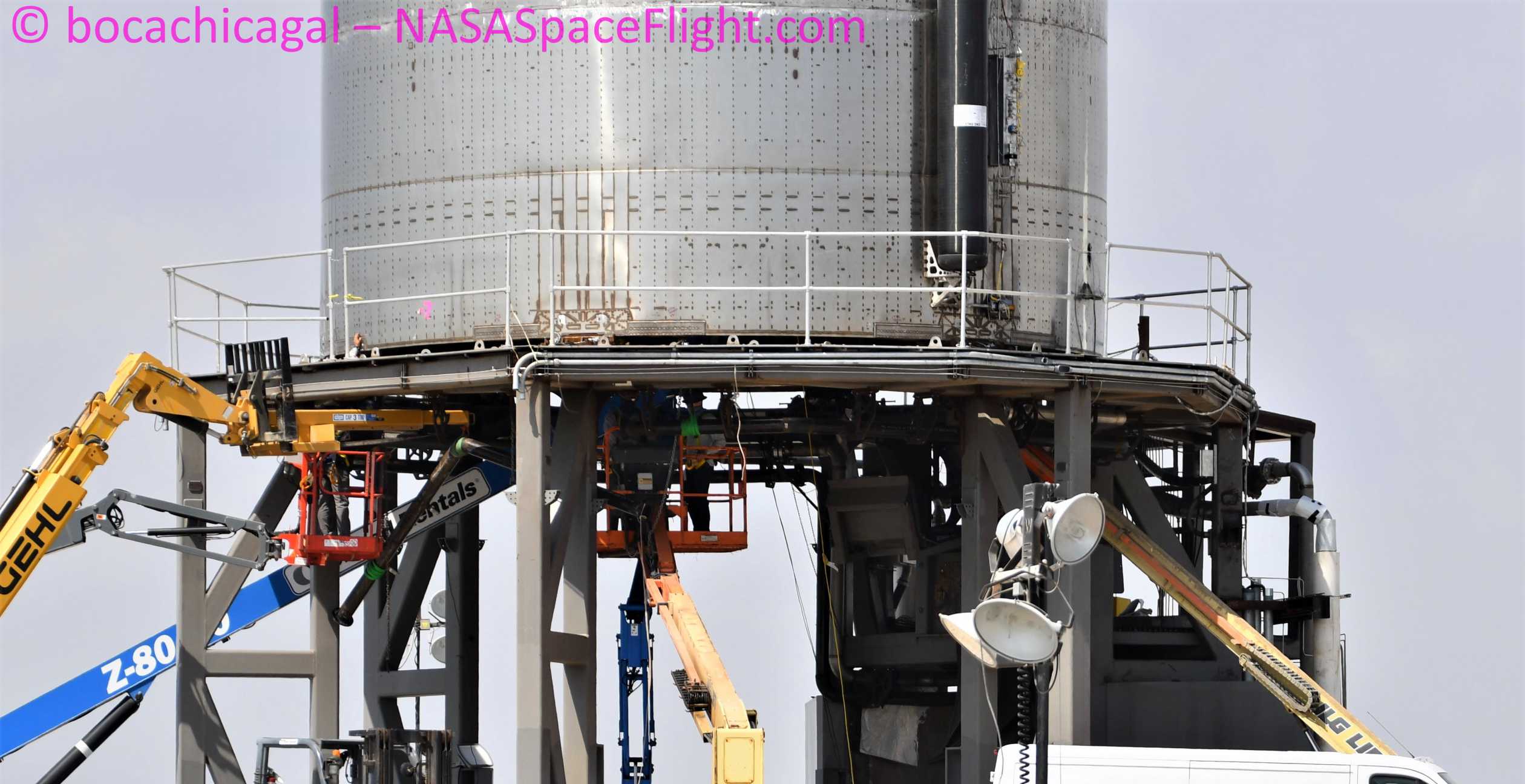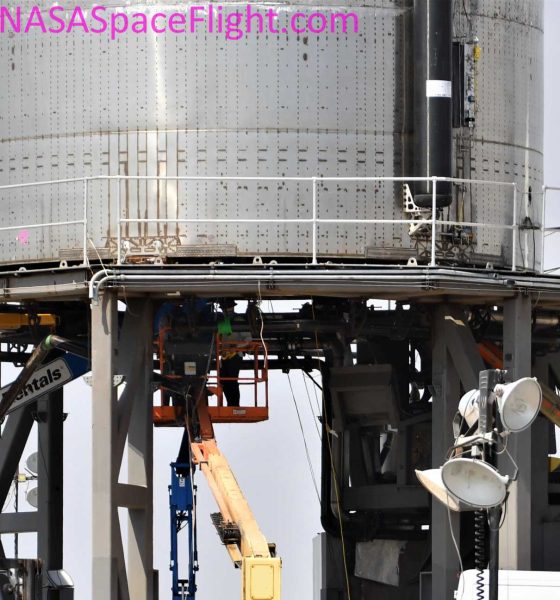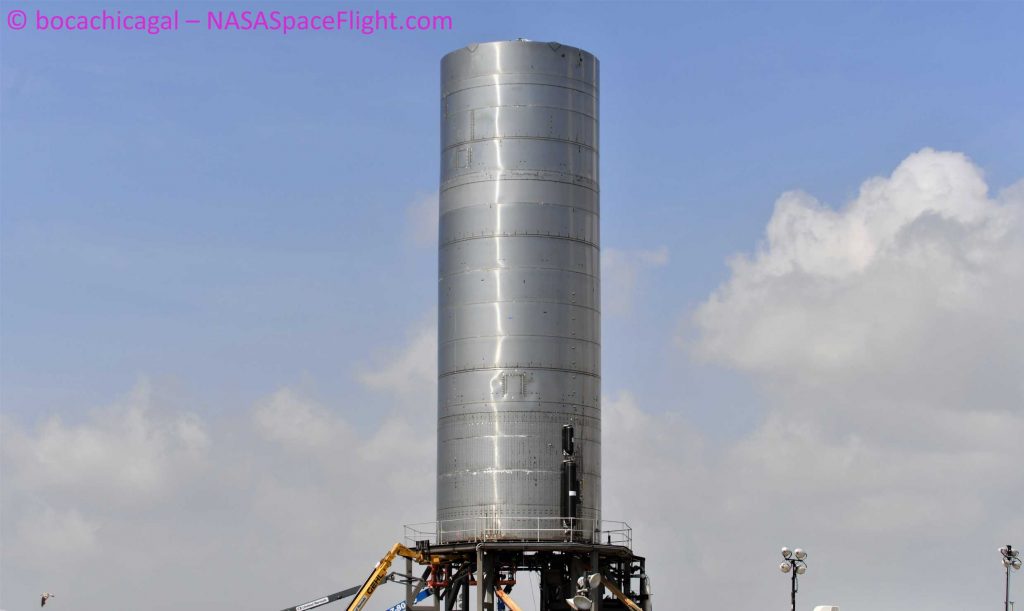

News
SpaceX’s first Starship flight (re)scheduled for next week
SpaceX’s fifth full-scale Starship prototype could become the first to take flight just a week or so from now if a Raptor engine test goes as planned early next week.
Known as Starship serial number 5 (SN5), SpaceX teams are currently in the process of completing the installation of Raptor SN27 and preparing the massive steel rocket for its first cryogenic wet dress rehearsal and static fire tests. Delayed from July 8th and 10th, Starship SN5’s first Raptor static fire is now scheduled no earlier than ~10 am CDT (~15:00 UTC) on Monday, July 13th.
If things go well during those nominally back-to-back tests, public road closure filings show that SpaceX wanted to attempt the first full-scale Starship hop just three days later, although the recent two-day delay adds a bit of uncertainty.

The odds are good that one or both of those test periods will slip or change in the next few days and, in fact, Starship SN5’s static fire test period was delayed two days while this article was in work. SpaceX could run into road bumps that prevent the July 10th 13th wet dress rehearsal (WDR) from smoothly transitioning into a Raptor static fire attempt and any number of additional delays could beset the actual flight test throughout the flow. Along the same lines as Starhopper, currently the only vehicle to have flown under the power of a Raptor engine, Starship’s flight computer could abort the launch at almost any point prior to liftoff, up to and including Raptor ignition.
Like Falcon 9 and Falcon Heavy, Starship (and Starhopper) will ingest and interpret hundreds or thousands of channels of telemetry to determine the health of its engines for a second or two after ignition while thrust is ramping. If the Raptor or Merlin engine(s) look healthy, the rocket commands hold-down clamp release and lifts off (or, in the case of Starhopper, uses its own immense weight to prevent liftoff until Raptor is throttled up).

Thanks to an upgraded launch mount, SpaceX’s full-scale Starship prototypes have access to built-in hold-down clamps, enabling operations that are at least a bit more similar to those used for Falcon 9 and Heavy launches. Starship’s six hold-down clamps are affixed to the same structure that the ship’s six landing legs are installed on.

Perhaps the single biggest point of uncertainty with Starship’s first full-scale test flight is its somewhat mysterious landing legs – almost entirely different from Falcon 9’s well-proven four-leg design. The stubby Starship legs stow inside the ship’s engine section, swinging down and out (and potentially telescoping, albeit much less than Falcon 9) come touchdown. Based on photos of the legs, they may also feature rudimentary shock absorption mechanisms, meaning that Starship should be able to tolerate slightly rougher landings. SpaceX has likely tested Starship leg deployment extensively on the ground but beyond that assumption, they remain an unproven mystery.
Regardless, SpaceX is going to be extremely busy over the next 7-10 days with Starlink-9 scheduled to launch NET July 11th, Starship SN5’s static fire NET July 13th, Falcon 9’s ANASIS II launch scheduled NET July 14th, and a potential SN5 hop test attempt as early as July 16th (speculation).
Check out Teslarati’s Marketplace! We offer Tesla accessories, including for the Tesla Cybertruck and Tesla Model 3.

Elon Musk
Elon Musk’s X will start using a Tesla-like software update strategy
The initiative seems designed to accelerate updates to the social media platform, while maintaining maximum transparency.

Elon Musk’s social media platform X will adopt a Tesla-esque approach to software updates for its algorithm.
The initiative seems designed to accelerate updates to the social media platform, while maintaining maximum transparency.
X’s updates to its updates
As per Musk in a post on X, the social media company will be making a new algorithm to determine what organic and advertising posts are recommended to users. These updates would then be repeated every four weeks.
“We will make the new 𝕏 algorithm, including all code used to determine what organic and advertising posts are recommended to users, open source in 7 days. This will be repeated every 4 weeks, with comprehensive developer notes, to help you understand what changed,” Musk wrote in his post.
The initiative somewhat mirrors Tesla’s over-the-air update model, where vehicle software is regularly refined and pushed to users with detailed release notes. This should allow users to better understand the details of X’s every update and foster a healthy feedback loop for the social media platform.
xAI and X
X, formerly Twitter, has been acquired by Elon Musk’s artificial intelligence startup, xAI last year. Since then, xAI has seen a rapid rise in valuation. Following the company’s the company’s upsized $20 billion Series E funding round, estimates now suggest that xAI is worth tens about $230 to $235 billion. That’s several times larger than Tesla when Elon Musk received his controversial 2018 CEO Performance Award.
As per xAI, the Series E funding round attracted a diverse group of investors, including Valor Equity Partners, Stepstone Group, Fidelity Management & Research Company, Qatar Investment Authority, MGX, and Baron Capital Group, among others. Strategic partners NVIDIA and Cisco Investments also continued support for building the world’s largest GPU clusters.
News
Tesla FSD Supervised wins MotorTrend’s Best Driver Assistance Award
The decision marks a notable reversal for the publication from prior years, with judges citing major real-world improvements that pushed Tesla’s latest FSD software ahead of every competing ADAS system.

Tesla’s Full Self-Driving (Supervised) system has been named the best driver-assistance technology on the market, earning top honors at the 2026 MotorTrend Best Tech Awards.
The decision marks a notable reversal for the publication from prior years, with judges citing major real-world improvements that pushed Tesla’s latest FSD software ahead of every competing ADAS system. And it wasn’t even close.
MotorTrend reverses course
MotorTrend awarded Tesla FSD (Supervised) its 2026 Best Tech Driver Assistance title after extensive testing of the latest v14 software. The publication acknowledged that it had previously criticized earlier versions of FSD for erratic behavior and near-miss incidents, ultimately favoring rivals such as GM’s Super Cruise in earlier evaluations.
According to MotorTrend, the newest iteration of FSD resolved many of those shortcomings. Testers said v14 showed far smoother behavior in complex urban scenarios, including unprotected left turns, traffic circles, emergency vehicles, and dense city streets. While the system still requires constant driver supervision, judges concluded that no other advanced driver-assistance system currently matches its breadth of capability.
Unlike rival systems that rely on combinations of cameras, radar, lidar, and mapped highways, Tesla’s FSD operates using a camera-only approach and is capable of driving on city streets, rural roads, and freeways. MotorTrend stated that pure utility, the ability to handle nearly all road types, ultimately separated FSD from competitors like Ford BlueCruise, GM Super Cruise, and BMW’s Highway Assistant.
High cost and high capability
MotorTrend also addressed FSD’s pricing, which remains significantly higher than rival systems. Tesla currently charges $8,000 for a one-time purchase or $99 per month for a subscription, compared with far lower upfront and subscription costs from other automakers. The publication noted that the premium is justified given FSD’s unmatched scope and continuous software evolution.
Safety remained a central focus of the evaluation. While testers reported collision-free operation over thousands of miles, they noted ongoing concerns around FSD’s configurable driving modes, including options that allow aggressive driving and speeds beyond posted limits. MotorTrend emphasized that, like all Level 2 systems, FSD still depends on a fully attentive human driver at all times.
Despite those caveats, the publication concluded that Tesla’s rapid software progress fundamentally reshaped the competitive landscape. For drivers seeking the most capable hands-on driver-assistance system available today, MotorTrend concluded Tesla FSD (Supervised) now stands alone at the top.
News
Elon Musk’s Grokipedia surges to 5.6M articles, almost 79% of English Wikipedia
The explosive growth marks a major milestone for the AI-powered online encyclopedia, which was launched by Elon Musk’s xAI just months ago.

Elon Musk’s Grokipedia has grown to an impressive 5,615,201 articles as of today, closing in on 79% of the English Wikipedia’s current total of 7,119,376 articles.
The explosive growth marks a major milestone for the AI-powered online encyclopedia, which was launched by Elon Musk’s xAI just months ago. Needless to say, it would only be a matter of time before Grokipedia exceeds English Wikipedia in sheer volume.
Grokipedia’s rapid growth
xAI’s vision for Grokipedia emphasizes neutrality, while Grok’s reasoning capabilities allow for fast drafting and fact-checking. When Elon Musk announced the initiative in late September 2025, he noted that Grokipedia would be an improvement to Wikipedia because it would be designed to avoid bias.
At the time, Musk noted that Grokipedia “is a necessary step towards the xAI goal of understanding the Universe.”
Grokipedia was launched in late October, and while xAI was careful to list it only as Version 0.1 at the time, the online encyclopedia immediately earned praise. Wikipedia co-founder Larry Sanger highlighted the project’s innovative approach, noting how it leverages AI to fill knowledge gaps and enable rapid updates. Netizens also observed how Grokipedia tends to present articles in a more objective manner compared to Wikipedia, which is edited by humans.
Elon Musk’s ambitious plans
With 5,615,201 total articles, Grokipedia has now grown to almost 79% of English Wikipedia’s article base. This is incredibly quick, though Grokipedia remains text-only for now. xAI, for its part, has now updated the online encyclopedia’s iteration to v0.2.
Elon Musk has shared bold ideas for Grokipedia, including sending a record of the entire knowledge base to space as part of xAI’s mission to preserve and expand human understanding. At some point, Musk stated that Grokipedia will be renamed to Encyclopedia Galactica, and it will be sent to the cosmos.
“When Grokipedia is good enough (long way to go), we will change the name to Encyclopedia Galactica. It will be an open source distillation of all knowledge, including audio, images and video. Join xAI to help build the sci-fi version of the Library of Alexandria!” Musk wrote, adding in a later post that “Copies will be etched in stone and sent to the Moon, Mars and beyond. This time, it will not be lost.”








